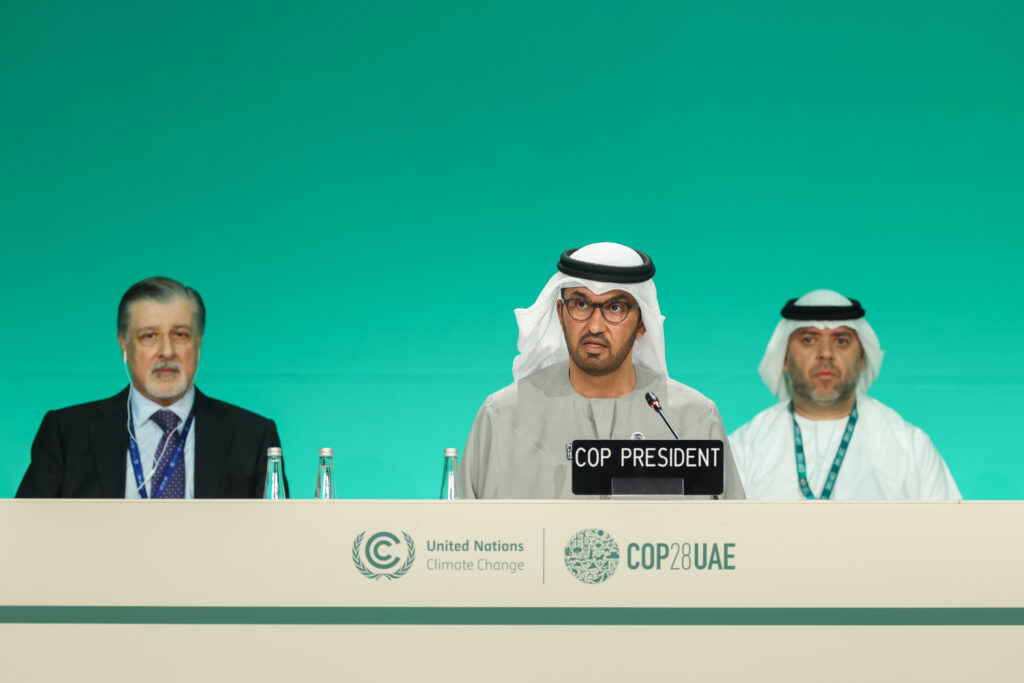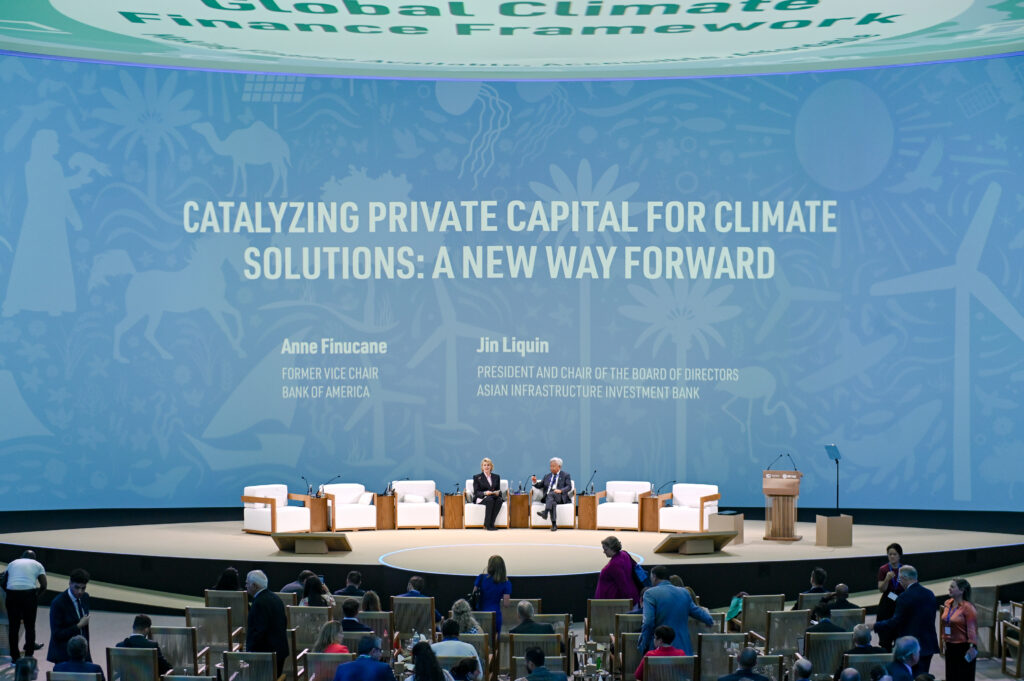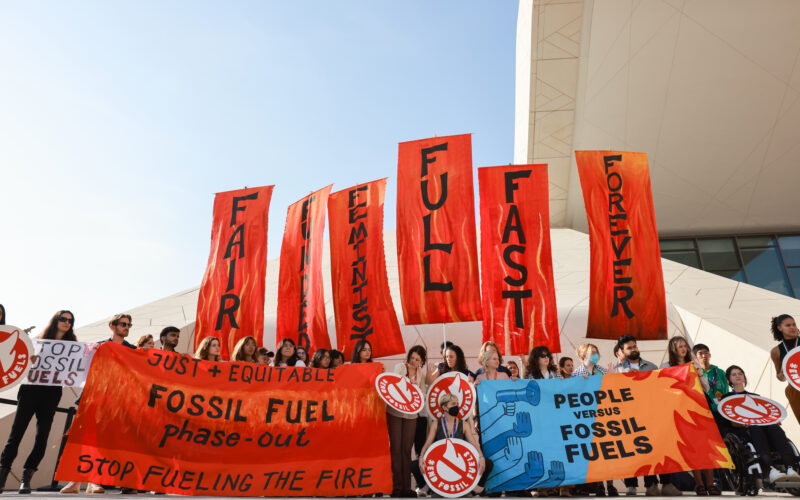The 28th Conference of the Parties to the United Nations Framework Convention on Climate Change, or COP28, took place between 30 November and 12 December. The event was held for over two weeks in Dubai, United Arab Emirates. As we experience our hottest year on record, over 70,000 people gathered at the conference to give updates on global climate change goals.
According to the UN Intergovernmental Panel on Climate Change, we need to lower our emissions by 45% by 2030, especially within the fossil fuel industry. And our use of renewable energy needs to triple by 2030.
This year’s conference aimed to get agreement on a new fossil fuel deal. But removing and watering down “phase out” to “phase down” terminology caused challenges with the conference going into overtime.
Notably the COP28 President Sultan Al Jaber (also the CEO of Adnoc oil) stated during the conference that there was “no science” for the need to phase out fossil fuels.
With greenhouse gases reaching new peaks in 2023 despite goals to reduce them, we break down some of the key highlights and what happened at COP28.

COP28 Priorities
The COP Presidency announced the COP28 priorities in a letter to parties in July 2023, stating the conference would focus on four paradigm shifts:
- Fast-tracking the energy transition and slashing emissions before 2030;
- Transforming climate finance, by delivering on old promises and setting the framework for a new deal on finance;
- Putting nature, people, lives, and livelihoods at the heart of climate action; and
- Mobilizing for the most inclusive COP ever.

Key Decisions
Priority #1 Fast Tracking The Energy Transition
1.1 Triple Renewable Energy
The International Energy Agency (IEA) and the International Renewable Energy Agency (IRENA) tells us that we need three times more renewable energy capacity by 2030 to limit warming to 1.5°C. And according to the IEA and Intergovernmental Panel on Climate Change (IPCC), if we want to meet the Paris Agreement goal, we need to couple renewable energy with improvements in energy efficiency and end investment in new coal-fired power plants.
Launched during COP28, the Global Renewables and Energy Efficiency Pledge includes commitments to triple renewable energy capacity to at least 11,000 GW by 2030 and double the global rate of energy efficiency improvements from 2% to 4%.
1.2 Fossil Fuel Phase Down
Notably one of the most challenging agreements coming out of the COP28 was the new deal on fossil fuel emissions. With many countries hoping for strong language around “phasing out” fossil fuels, in the end an agreement was made to “phase down”.
The first Global Stocktake agreed at COP28 outlines transitioning away from fossil fuels and achieving net zero by 2050. More than 50 oil companies also signed the Oil and Gas Decarbonization Charter committing to net-zero operations by 2050 at the latest, ending routine flaring by 2030 and near-zero upstream methane emissions.
1.3 Reduce Cooling Emissions
As the world’s average temperature increases, almost one-third of people are now facing dangerously high temperatures for more than 20 days each year. Heatwaves now cause 12,000 deaths annually but only 8% of those living in the poorest parts of the world have AC in their homes.
As demand for cooling increases, it’s expected to be one of the top drivers of electricity usage over the next few decades using as much electricity by 2050 as China and India today. But conventional cooling, like air conditioning, is a major greenhouse gas offender accounting for 7% of total global emissions.
The Global Cooling Pledge for COP28 lays out passive cooling strategies like insulation, natural shading, higher energy efficiency standards and a rapid phase down of the use of hydrofluorocarbon (HFC) refrigerants. The pledge was signed by 66 national governments with the goal of reducing cooling-related emission by a minimum of 86% compared to 2022 levels by 2050.
Priority #2 Fixing Climate Finance
2.1 Fund Loss and Damage
The decision to establish a loss and damage fund to help developing countries deal with the effects of climate change was made at last year’s COP27. But financial commitments to the fund have been low with an estimated $400 billion needed per year.
To date, wealthy countries have pledged just over $700m to the loss and damage fund, a drop in the bucket compared to what’s needed. Canada pledged just $16 million to the fund compared to pledges from Italy and France for over $108 million each.
Operationalization and funding arrangements for the loss and damage fund were agreed on the opening day. The UN Office for Disaster Risk Reduction (UNDRR) and the UN Office for Project Services (UNOPS) will also host the secretariat of the Santiago Network for Loss and Damage. The goal is to use this platform to provide technical assistance to developing countries, especially those that are vulnerable to the effects of climate change.
2.2 New Climate Finance Framework
We need between $5-7 trillion every year to achieve our climate goals. Not an amount that developing countries can easily find leaving many with the prospect of choosing between fighting poverty or fighting climate change.
The UAE Leaders’ Declaration on a Global Climate Finance Framework aims to make finance available, accessible and affordable. Endorsed by 13 national governments (Canada isn’t one of them) the framework includes the need for developed countries to mobilize $100 billion in meaningful mitigation action through to 2025.
2.3 Finance For Nature
Reversing nature loss itself can help our mitigation actions by more than 30%, helping keep global warming within 1.5°C. Nature preservation can also provide $10 trillion worth of new business opportunities and almost 400 million new jobs.
Nature, Land Use and Ocean Day at COP28 saw the announcement of $186.6 million in new financing for nature and climate towards forests, mangroves, and the ocean.
The COP28 Presidency and the People’s Republic of China, as President of the Convention on Biological Diversity, also released a new statement committing countries to coordinate and simultaneously implement their climate strategies.
Priority #3 Focusing On People, Lives And Livelihoods
3.1 New Adaptation Framework
With almost half of the world’s population at risk of the impacts of climate change the need to scale up efforts to protect vulnerable communities is becoming increasingly evident.
The Global Goal on Adaptation (GGA) made some strides at COP28 although key areas like financial support for developing countries are still missing from the agreement.
The GGA was established in 2015 but it hasn’t had quantifiable targets to work towards and progress has been slow. The framework will be enhanced over the next two years including adding measurable indicators to track progress.
3.2 Commitment To Climate Relief
Recognizing the billions of people globally threatened by climate crisis, 78 national governments (including Canada) endorsed the COP 28 UAE Declaration on Climate Relief, Recovery and Peace.
The declaration calls for an increase in climate action, access to finance for countries facing severe humanitarian needs and collaboration at multiple levels to address the challenges of climate change.
3.3 Reinforced Connection Between Climate And Health
As countries become more industralised, their air becomes more polluted. Air pollution is now one of the largest environmental and health risks on the planet causing 4.14 million deaths in 2019. Coupled with other climate change associated health risks from flooding to extreme temperatures, we need increased urgency in a climate-resilient healthcare systems.
Reinforcing the connection between health and climate, 141 national governments (including Canada) agreed to the COP 28 UAE Declaration on Climate and Health. The declaration focuses on the advancement of climate-resilient development, the strengthening of health systems, and the building of resilient and thriving communities, for the benefit of present and future generations.
Priority #4 Inclusivity For All
4.1 Gender Equity
Women face disproportionate impacts of climate change and are 14 times more likely to be harmed during a disaster. They’re often employed in sectors most likely to be impacted by climate change like tourism, the care economy and the garment industry. Not to mention an increase in gender-based violence as climate change exacerbates existing inequalities.
The COP 28 Gender-Responsive Just Transitions and Climate Action Partnership was launched with the support of 78 national governments (including Canada). The Partnership commits to working collaboratively to drive gender-responsive just transitions, strengthening all women’s leadership and livelihoods in climate action. The Partnership will provide an update on progress made at COP31.
4.2 Indigenous Peoples
Indigenous peoples have one of the closest relationships to the environment and because of this they’re one of the first to face direct consequences of climate change. Indigenous peoples in the Amazon rainforest region have seen almost 20% of the rainforest destroyed, impacting livelihoods and causing severe knock-on effects like droughts and wildfires. In the Arctic region sea ice cover is now reducing at a rate of 31,100 square miles per year. This makes it incredibly difficult and dangerous for the Indigenous peoples in the region to hunt, maintain cultural traditions and sustain a livelihood.
The Podong Indigenous Peoples Initiative was launched during COP28. Indigenous Peoples currently receive less than 3% of international climate finance but this initiative aims to provide funding directly to Indigenous Peoples, ensuring no less than 85% of funds reach Indigenous territories and communities.
4.3 Increasing Youth Participation
63% of the world’s population is 39 or younger, 33% are less than 20 years old. With the bulk of the world’s population being classified as a youth (35 years and younger) it only makes sense to include them in our climate action plans. In fact 69% of Canadians think the work and voices of young people can inspire important climate action.
Outcomes of the Youth Stocktake were announced at COP28, supported by the COP 28 Presidency, the Youth Climate Champion and YOUNGO. Key recommendations from the Youth Stocktake including enhancing the availability of data, building trust and accountability, structuring youth inclusion and mobilising funding.
The above list of outcomes from COP28 is intended to give a brief summary of a selection of key priority initiatives only. It is not intended to serve as the entire list of outcomes established during the conference. For more information on the entire list of outcomes and decisions, visit the COP28 website.






